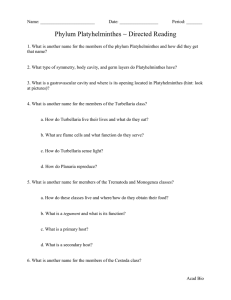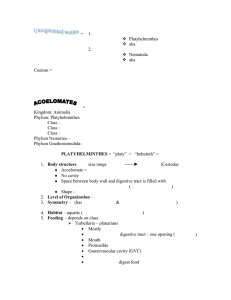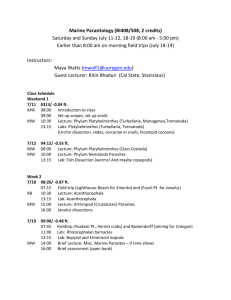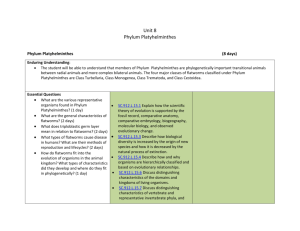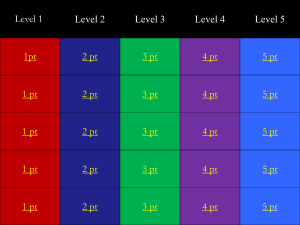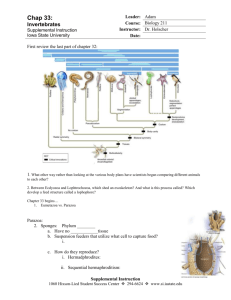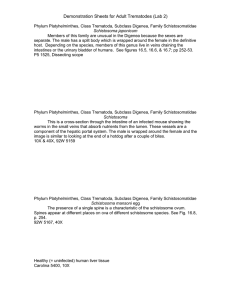Demonstration Sheets for Turbellaria, Monogenea & Larval Trematodes (Lab 1)
advertisement
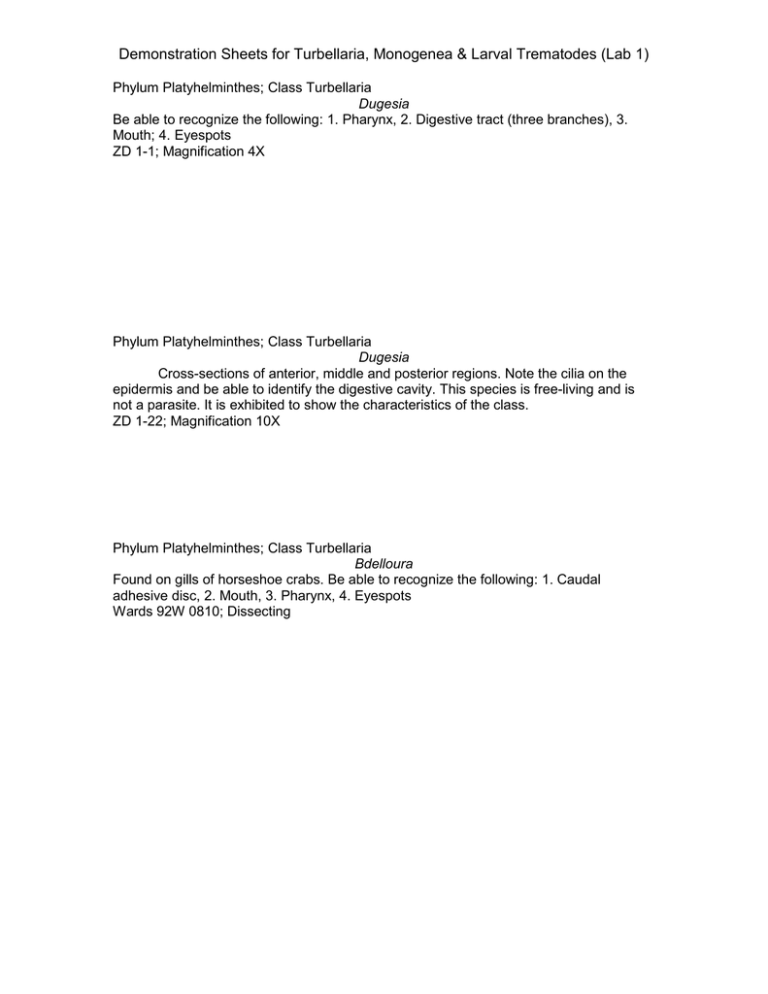
Demonstration Sheets for Turbellaria, Monogenea & Larval Trematodes (Lab 1) Phylum Platyhelminthes; Class Turbellaria Dugesia Be able to recognize the following: 1. Pharynx, 2. Digestive tract (three branches), 3. Mouth; 4. Eyespots ZD 1-1; Magnification 4X Phylum Platyhelminthes; Class Turbellaria Dugesia Cross-sections of anterior, middle and posterior regions. Note the cilia on the epidermis and be able to identify the digestive cavity. This species is free-living and is not a parasite. It is exhibited to show the characteristics of the class. ZD 1-22; Magnification 10X Phylum Platyhelminthes; Class Turbellaria Bdelloura Found on gills of horseshoe crabs. Be able to recognize the following: 1. Caudal adhesive disc, 2. Mouth, 3. Pharynx, 4. Eyespots Wards 92W 0810; Dissecting Phylum Platyhelminthes; Class Monogenea Ergocotyle Notice the bear trap-like hooks on the opisthaptor. These worms parasitize gills and can kill sharks in public aquaria. Host was a bonnet-head shark in the Tennessee Aquarium that had been born in cavity. Magnification 10X Phylum Platyhelminthes; Class Monogenea Neobenedenia Observe the characteristic hooks on the OPISTHAPTOR. Magnification 4X Phylum Platyhelminthes; Class Monogenea Gyrodactylus Important pests of trout, bluegills and goldfish in fish ponds. VIVIPAROUS (= live birth) Parasites are adults at birth. Offspring developing in uterus of parent have developing embryos in their uteruses, an adaptation resulting in exponential population growth. See pages 303-304 of your text & Fig 19.14. PS 1202; Magnification 40X Phylum Platyhelminthes; Class Monogenea; Neopolystoma Parasitic in urinary bladder of turtles. This specimen was taken from a red-bellied slider collected in the Mobile Delta. The opisthaptor does not have hooks nor anchors. Specimen; dissecting scope Phylum Platyhelminthes, Class Trematoda, Subclass Digenea Eggs of Schistosoma mansoni This is a very important human parasite in Asia. The eggs are found in feces of infected humans. If the person defecates in freshwater, a free swimming “miracidia” larva will emerge from the egg. Eggs of the trematode genus Schistosoma can be recognized by the presence of a pointed spine. 92W 5167; Magnification 40X Phylum Platyhelminthes, Class Trematoda, Subclass Digenea Miracidia Trematode larval stage that infects the 1st intermediate host, always a mollusk. Note that the organism has a relatively large eyespot and the external surface appears “fuzzy” due to the presence of cilia. Turtox P5.126; Magnification = 40X Phylum Platyhelminthes, Class Trematoda, Subclass Digenea SPOROCYST Found in the 1st intermediate host (usually gastropod snails). Sporocysts are basically sacs whose internal lining asexually produces embryo-like clones. Unlike another trematode stage found in 1st intermediate host e.g. rediae, sporocysts do NOT have mouths. Snail hosts are castrated. PS 1420; Magnification = 4X Phylum Platyhelminthes, Class Trematoda, Subclass Digenea REDIAE Found in the 1st intermediate hosts (usually gastropods). These stages reproduce asexually (daughter rediae are visible inside these specimens). They castrate their snail hosts. PS 1430; Magnification = 40X Phylum Platyhelminthes, Class Trematoda, Subclass Digenea CERCARIAE of Schistosoma This swimming stage hatches from a redia in the 1st intermediate host and burrows into the skin of people working in rice paddies. This infective stage is not reproductive. Each larva has to potential to become only one adult Magnification = 10x Phylum Platyhelminthes, Class Trematoda, Subclass Digenea Cercaria This family of digenetic trematodes produces very large (relatively speaking) cercariae & can be found in Alabama freshwater streams. Predatory fish are attracted to the big, slow-swimming cercariae and “feed” (Deep thought: Who feeds upon whom?) upon them. Adult worms are in the digestive tracts of predatory fish. 92W 5010; Dissecting scope Phylum Platyhelminthes; Class Trematoda; Subclass Digenea Metacercariae The metacercariae of this species of trematode, Microphallus turgidus are common in grass shrimp in local salt marshes. The larvae are visible as circular balls within the muscle tissue in the tail. Sometimes there may be over 50 metacercariae in one shrimp as seen in the adjacent photo. The bright red metacercariae in the photo are examples of hyperparasitism as they are infected with a haplosporidian protozoan. Specimen; dissecting microscope
